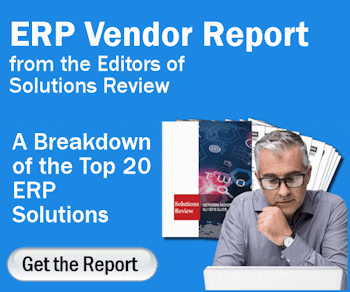Navigating Software Complexity’s Challenges Across Implementation, Budget, and Mission-Critical Operations


As part of Solutions Review’s Contributed Content Series—a collection of contributed articles written by our enterprise tech thought leader community—Eric Helmer, the SVP and Chief Technology Officer at Rimini Street, offers some guidance on navigating the challenges involved with software implementation, budget, upgrades, and more.
 Organizations today are encountering significant complexities when undertaking the migration to new versions of enterprise resource planning (ERP) systems or integrating new solutions into their core frameworks. Successfully managing this complexity is pivotal to avoid the venture turning into an excessive drain on resources and investments. However, embarking on a new ERP journey is not a straightforward task. Read on to gain a better understanding of the intricacies of ERP and ‘back-office’ software and explore the challenges from various standpoints, including implementation, budgetary constraints, and the importance of mission-critical operations.
Organizations today are encountering significant complexities when undertaking the migration to new versions of enterprise resource planning (ERP) systems or integrating new solutions into their core frameworks. Successfully managing this complexity is pivotal to avoid the venture turning into an excessive drain on resources and investments. However, embarking on a new ERP journey is not a straightforward task. Read on to gain a better understanding of the intricacies of ERP and ‘back-office’ software and explore the challenges from various standpoints, including implementation, budgetary constraints, and the importance of mission-critical operations.
Understanding the Complexity of the Software Landscape
ERP systems serve as the backbone of modern business operations and are designed to streamline and integrate various core processes such as finance, human resources, supply chain management, procurement, and more. These systems are essential for businesses aiming to optimize their operations, enhance efficiency, and help organizations gain competitive advantages.
As organizations strive to remain competitive and adaptable, they often face a confluence of factors that contribute to the increasing complexity of ERP migration and integration. The impact of these challenges is far-reaching, affecting not only the technical aspects of a technology leader but also the financial health of the business and the crucial continuity of mission-critical operations.
Challenges in Migration, Upgrades, and Integration
The process of migrating to a new ERP system, upgrading to a new version, or integrating additional solutions can involve a collection of technical challenges around migrating data from legacy systems, customizing the system to align with unique business needs, and ensuring seamless compatibility with existing systems. If not handled with precision, these complexities can lead to system downtime, data loss, and operational disruptions.
Implementation and Upgrade Hurdles
Upgrades, while intended to improve functionality, inevitably bring about a level of disruption to ongoing operations. While an upgrade may seem focused on only a few enhancements, the reality is that it will likely touch upon all modules of the ERP system. In a tightly interwoven environment, changes in one area can trigger a cascade of effects across the entire infrastructure and introduce unexpected disruptions. Additionally, many so-called “upgrades” today actually involve a full re-implementation within a vendor’s cloud infrastructure. This means that an organization’s data gets moved outside its own data center, which introduces new integration challenges.
Budgetary Constraints
As ERP projects become more frequent and complex, organizations tend to exceed their initial budgets due to unforeseen challenges and additional requirements. According to ASUG’s 2023 Pulse of the SAP Customer Research, 24 percent of respondents are upgrading their SAP systems between every 2-4 years, 18 percent are upgrading annually, and some, more than once per year (8 percent). However, 67 percent are only ‘somewhat able to keep up’ with the pace of SAP updates, and 10 percent say they are not able to keep up, with concerns expressed such as this response: “The sheer volume and frequency of updates make it difficult to assess what will be beneficial or have a meaningful impact, let alone go through with the update.”
The cost of upgrading is the primary reason companies struggle to do so, especially when they face unexpected expenses related to data migration, training, and unanticipated technical issues. Beyond that, many do not take into consideration the return on investment (ROI), which must be a deciding factor for any change, as it is not only the upfront expense but the expectations for year-over-year payback. Overall, leaders will have to ask how these expenses will provide a result for the overarching business goals.
Importance for Mission-Critical Operations
ERP systems have evolved from being backend tools to critical components of business operations. From supply chain management to financial transactions, organizations heavily rely on ERP systems to ensure seamless and efficient operations. Any disruption during migration or integration can ripple across departments, causing operational bottlenecks and ultimately harming customer experiences.
Strategies for Managing the Complexity
Meticulous planning—which includes setting clear goals and outlining a well-defined roadmap—is the cornerstone of successful ERP migration and integration. However, for that planning to be effective, organizations must conduct comprehensive assessments of their existing systems, business processes, and potential obstacles, including downtime through testing and integrations, change management, or training.
In many cases, performing a feature-by-feature analysis can help organizations determine if new versions have features that will provide a strong return on investment (ROI) or if they would just be simply nice to have.
Collaboration and Communication
Cross-departmental collaboration is essential to gather insights from different perspectives. Effective communication between IT teams, stakeholders, and end-users facilitates alignment and reduces misunderstandings. By sharing knowledge and experiences, teams can make informed decisions and adapt to changing circumstances more efficiently. Learning what works will support the team to maintain those systems, and understanding what creates obstacles will allow to drive change.
Human Expertise and Tools
Engaging experienced consultants and ERP specialists can significantly ease the complexities of migration and integration. Their expertise in handling diverse scenarios, along with the use of advanced tools and technologies, can accelerate the process while minimizing risks. Successful examples demonstrate how external expertise can also lead to smoother, cost-effective implementations.
Navigating Complexity with Confidence
Businesses striving to stay competitive and responsive must be prepared to overcome the hurdles associated with systems upgrades, integrations, or new implementation projects. ERP transformation is not as easy as simply migrating from one version to another. By understanding the intricacies of ERP transformation, adopting proactive strategies, and learning from both successes and setbacks, IT professionals can position their organizations for successful transitions that drive growth and innovation.























